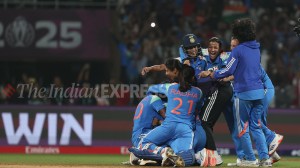How the Mohali Test was won
While several reasons have been attributed to India’s record victory against Australia in Mohali, primary among them is the Indian fast bowlers’ ability to get the ball to reverse swing as early as the 8th over of the innings.

While several reasons have been attributed to India’s record victory against Australia in Mohali, primary among them is the Indian fast bowlers’ ability to get the ball to reverse swing as early as the eighth over of the innings. Caught totally unawares by this unheard-of phenomenon, the Australian batsmen were sitting ducks as the team spiralled to defeat. On Wednesday, a day after the match ended, sources in the Indian team revealed that they had indeed managed to master a new brand of reverse swing in which, rather than waiting for the ball to scruff up naturally with passage of time and overs, the Indians managed to create that condition early. And all this, they stressed, was done perfectly within the rules of the game.
While bowlers such as Sarfraz Nawaz and Imran Khan have been called the fathers of reverse swing — the art of making the old ball swing into a right-hand batsman at great speed — Zaheer Khan is now being tipped as the king of this ‘new reverse swing,’ which was executed with the help of bowling coach Venkatesh Prasad, deep back-end study, and the entire fielding unit.
This new style didn’t crop up all of a sudden — it was a gradual work-in-progress in coaching camps, with a dummy run in the Irani Cup match in Vadodara, where Zaheer ran through the Delhi batting on a dry wicket along with first-change bowler Munaf Patel.
How it is done
In Mohali, Zaheer and Ishant bowled a lot of deliveries cross-seam with the new ball, rather than bowling seam-up and allowing the ball to swing. A Team India member explained: “The new SG Test ball doesn’t swing much. When the fast bowlers bowl cross-seam, the ball inevitably lands on the sides. With a dry pitch like Mohali, the soft leather on the ball gets roughed up very quickly. And at the time of release, a bowler can ensure he keeps hitting one side of the ball to scruff it up more. At the same time, the soft leather can be repaired quickly, so the fielders keep shining the other side to protect it.”
Once the ball gets scruffy from one side, the worldwide formula of using mints and jelly beans for more sugary saliva, throwing one bounce, and keeping the ball dry is religiously followed.
Reverse vs New reverse
This new brand is different from traditional reverse swing. In this case, the ball is still hard and thereby requires to be bowled at a different length. Former India paceman Amit Bhandari who, along with Ishant Sharma, produced reverse swing in a Ranji match against Andhra Pradesh as early as in the fifth over, explains the difference. “First thing to remember is that the ball is hard. So it makes sense to hit the deck rather than going for the conventional full length. It takes a lot of effort for a bowler to bowl reverse swing with the old ball because pace is essential. That effort gets reduced drastically with the hard ball,” he says.
Bhandari adds: “The first thing is to hit the ball three-quarters of length. If you look at the replays of Ricky Ponting, Shane Watson and Brad Haddin’s dismissals, they were done in as the ball cut back sharply into them. The ball is still hard and, when it starts reversing, you can afford to pitch it slightly shorter while expecting more response off the wicket. The idea is to make the batsman play all six deliveries in an over, and the field setting is very important,” he says.
Incidentally, the opening spells of fast bowlers have been short, and Zaheer and Ishant have been kept fresh to bowl all out with the semi-new ball.
Optical illusion
Vivek Razdan, former India fast bowler and one of the operators when India undid Pakistan with reverse swing during the 1989 tour, says another interesting aspect to this new reverse swing is creating an optical illusion.
“Reverse swing has to do with lighter side and heavier side, not necessarily with the shiny and rough side. At the same time, the batsman cannot know which side is heavier or lighter, he can only pick the shine from the point of release. There can be conditions where the fielders work on the ball in such a manner that the shiny side isn’t necessarily the heavier side,” he says.
Razdan applauds this Team India for being able to get early reverse swing so easily. “During our days, it took great effort to get the ball to reverse, we were told that while holding the ball, even our palm shouldn’t touch it because then our sweat will affect the balance of the ball.”
Why Aussies didn’t reverse
Manoj Prabhakar, India’s original king of reverse swing, says Australians are looking to hit different lengths and are bowling a lot shorter for the ball to reverse.
“The Australian team seems to have little idea of taking care of the SG ball. That’s always the key. Also, they need to realize all the little aspects that can affect the balance and condition of the ball. The Australians have a high-arm action, which makes it difficult to get even normal reverse swing,” he says.
With the Delhi wicket again looking more on the drier side, Team India will be hoping their new brand of reverse swing helps them clinch the four-match Test series at the Kotla.
Greg Chappell maintained during Australia’s pre-tour camp in Jaipur that the players who knew the reverse swing would play a vital part in the series and there were plans in place to tackle that. But Team India may just have taken their game a few steps ahead during his transition time from the Indian to the Australian dressing room.



- 01
- 02
- 03
- 04
- 05



























